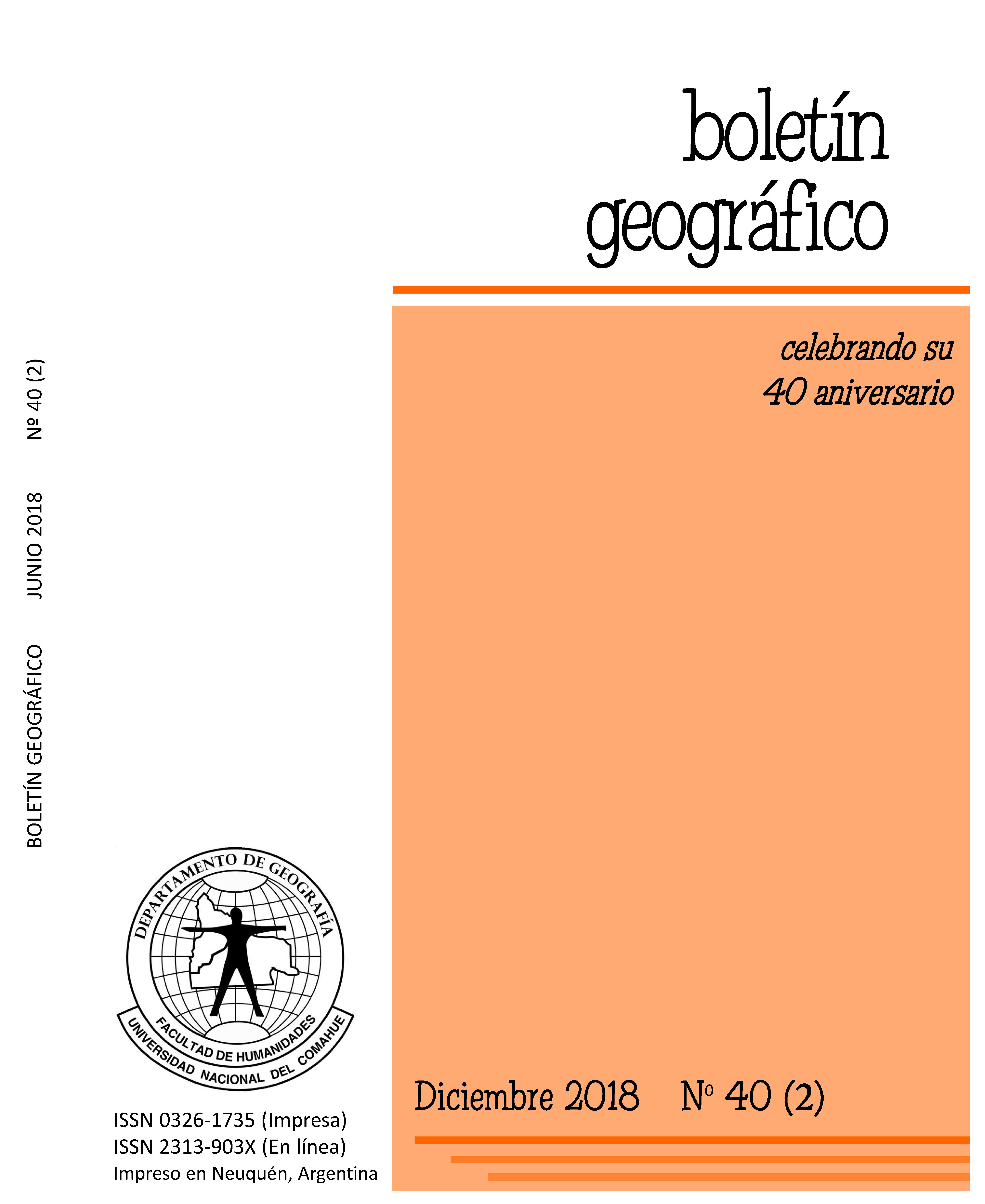WATER QUALITY FOR IRRIGATION: HISTORICAL AND CURRENT SITUATION OF THE COLORADO RIVER
Keywords:
Irrigation, Flow, Electrical conductivity, PHAbstract
The quality of water for irrigations is conditioned by salt (amount and type) and the sediment it has. The characteristics of the water destined for irrigation influence the edaphic properties, the yield of the crops, the infrastructure of the irrigation systems and the durability of pressurized irrigation systems. The objective of this work was to compare the current data (2014-2017) and those from the historical series (1969-2007) of electrical conductivity (CE), total dissolved solids (TSD) and pH in the Multiple Use System of the Colorado River in 25 de Mayo (La Pampa). These parameters were periodically determined, on the matrix channel, which leads the water to the irrigated area of 25 de Mayo. The annual and inter annual behavior of the parameters in this period was analyzed regarding the monthly average values of the historical series that belong to the Ente Provincial del Río Colorado (Government of La Pampa).The analyzed results indicate that the monthly average of the EC and TSD of the last four years are higher than the monthly historical average. The pH was higher than the monthly historical average during 2014, except for the months of November and December. In 2015 and 2016, the registered values were lower than the historical ones. The changes of the analyzed results, specifically the salinity (EC and TSD), could be due mainly to the decrease in the flow that has been registered in the last years.
Downloads
References
Allison, L.E., Bernestein, L., Bower, C.A., Brown, J.W., Fireman, M., Hatcher, J.T., Hayward, W.H.E., Pearson, G.A., Reeve, R.C., Richards, L.A. & Wilcox, L.V. (1954). Diagnóstico y rehabilitación de suelos salinos y sódicos. Secretaria de Agricultura y Ganadería, INIA, México.
Beget, M.E.; Di Bella, C.; Aumassanne, C.; Fontanella, D.; Sartor, P.; Lambert, M.J. (2016). Evaluación de la eficiencia del uso de agua de riego en un cultivo de maíz. Primera Reunión Científica del Programa Nacional Recursos Naturales, Gestión Ambiental y Ecorregiones del INTA (PNNAT). INTA Ediciones.
Comité Interjurisdiccional del Río Colorado (COIRCO) (2013). Reglamento y Estatuto COIRCO.
http://www.coirco.gov.ar/download/institucionales/institucionales-coirco/Reglamento%20y%20Estatuto%20Coirco.pdf (Fecha de consulta:noviembre de 2017).
Comité Interjurisdiccional del Río Colorado (COIRCO) (2014). Programa Integral de Calidad de Aguas del Río Colorado–Calidad del Medio Acuático. Informe Técnico.
Comité Interjurisdiccional del Río Colorado, Secretaría de Energía de la Nación, Grupo Interempresario. Disponible en: www.coirco.com.ar (Fecha de consulta: enero 2018).
Conti, M.E. & Giuffré, L. (2014). Edafología, bases y aplicaciones ambientales Argentinas. Ed. Facultad de Agronomía, UBA.
Halcrow, (2013). Cuenca del río Colorado, Determinación de Áreas de Riesgo Hídrico. Programa Multisectorial de Preinversión III. Tomo I.
INTERCONSUL S.A., ADE S.A. & FRANKLIN CONSULTORA S.A. (1982). Estudio de revisión y actualización del sistema de aprovechamiento múltiple del Río Colorado en Colonia 25 de Mayo - La Pampa. Informe Final. Sumario Plan de Desarrollo. Consejo Federal de Inversiones. II: C51 - C55.
Morábito, J., Salatino, S., Medina, R., Zimmermann, M., Filippini, M., Bermejillo, A., Campos. S., Nacif, N., Dediol, C., Genivese, D., Pizzuolo, P., Mastrantonio, L. & Valdés, A. (2007). Calidad del agua en el área regadía del río Mendoza: temperatura, pH, iones solubles y sólidos. Rev. FCA UNCuyo. 39(1): 9-20.
Richter, A. & Reinaudi, L. (2010). Estudio de la salinidad y de macroiones del río Colorado. III Congreso Pampeano del Agua, Santa Rosa, La Pampa.
Rhoades J.D., Kandiah A. & A.M. Mashali. (1992). The use of saline waters for crop production. FAO. Irrigation and Drainage. Paper 48, Rome, Italy.
Zamora, C.D., Sartor, P., Fontanella. D., Aumassanne, C., Fontana, L. & Ruiz, M.A. (2016). Evaluación de la producción de materia seca en variedades de alfalfa (Medicago sativa) de diferentes grados de reposo invernal, en el área bajo riego de La Pampa. 39o Congreso de la Asociación Argentina de Producción Animal – RAPA, 36 (1): 332.
Published
How to Cite
Issue
Section
License
Copyright (c) 2018 Boletin GeográficoTransfer of rights and data processing
The acceptance of an article for publication in the Journal Geographic Bulletin implies the cession of the rights of printing and reproduction, by any means and means, of the author in favor of the Department of Geography of the National University of Comahue, which will not reject any request reasonable for the authors to obtain permission to reproduce their contributions. The total or partial reproduction of the works published in the Geographic Bulletin must be done citing the origin, otherwise, the copyright is violated.
Likewise, it is understood that the concepts and opinions expressed in each work are the sole responsibility of the author, without being responsible or in solidarity, necessarily, neither the editorial staff nor the editorial staff.
It is the responsibility of the authors to be able to provide interested readers with copies of the raw data, procedure manuals, scores and, in general, relevant experimental material.
Likewise, the Management of the journal guarantees the appropriate treatment of personal data
COPYRIGHT TRANSFER FORM

















 Journal of the
Journal of the 